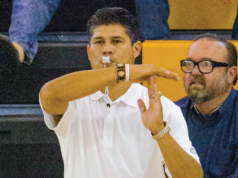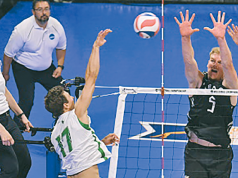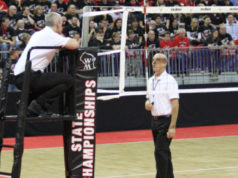“Spectacularity” sounds made-up and highfaluting, doesn’t it? Au contraire.
This actual word should be in every referee’s vocabulary. What does it mean, anyway? And how is it relevant to officiating?
Spectacularity is a hustling or extraordinary effort by a player to play the ball that results in the inner fan in you, the referee, silently raving, “Wow! Nice play.” It can occur at any level of competition.
What may apply for one level doesn’t necessarily apply for another level. Spectacularity is to be judged in relation to the caliber of the competitors present.
Regardless of the degree of spectacularity, a referee must remain objective and call any absolute or clear-cut ballhandling violation. Of course, some referees, jokingly or not, consider every ball contact a spectacularity and seldom call anything at all. That’s fine and dandy, provided they know what has to be called, are consistent in choosing what not to call and can sell their decisions.
More often than not, spectacularity will be a borderline ballhandling violation. That is due to the quick reacting player lacking a good, fundamental playing position or making an unorthodox contact. The dazzling outcome may draw cheers and “ooohs” from the spectators (as opposed to groans and “whoas”) and respect from the players and coaches.
Keep the whistle in check. Be sure of a ballhandling violation before halting a
sensational action exhibiting athleticism. Don’t get noticed, let alone have your judgment questioned, by killing the excitement with an iffy call that no doubt will be unpopular.
Uninterrupted spectacularity outweighs whistling its debatable illegality in terms of game flow and entertainment value. The opposing team may perceive a spectacularity to be
illegal and complain about a no-call. By the same token, if a teammate of theirs performed a similar outstanding feat, they would not want it called. Well, they can’t have it all. Call it the same way for both teams to avoid trouble.
Stay alert. Don’t get caught up in admiring the spectacularity. Concentrate on the plays that follow, especially the very next one. The sometimes less than desirable ball path from spectacularity could lead to a ballhandling error. Anticipate a “bang-bang” play.
A “let ‘em play” officiating philosophy isn’t being advocated, far from it. An official still must employ a correct and consistent standard for judging routine ballhandling. On the other hand, understand the principles and parameters of spectacularity. The large gray area for judgment calls gives a referee lot of leeway toward rewarding a thrilling, athletic effort by a player. Exercise this advantage without compromising the enforcement of
rules.
Promote the sport for the benefit and pleasure of the players and fans.
What's Your Call? Leave a Comment:
Note: This article is archival in nature. Rules, interpretations, mechanics, philosophies and other information may or may not be correct for the current year.
This article is the copyright of ©Referee Enterprises, Inc., and may not be republished in whole or in part online, in print or in any capacity without expressed written permission from Referee. The article is made available for educational use by individuals.


















